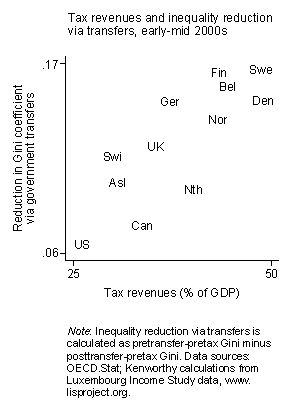"Reducing Inequality: How to Pay for It April 17, 2009
The Labour Party returned to power in the U.K. in 1997 based in part on a pledge by Tony Blair and Gordon Brown not to raise taxes’ share of the British economy. In his 2008 presidential campaign, Barack Obama promised to reduce taxes for the bottom 95% of Americans. In both instances this commitment succeeded in insulating the progressive candidate from what had become the right’s most powerful electoral club: stoking fear of tax increases by the left.
But while it may be smart electoral politics, committing not to increase taxes’ share of GDP, as Blair did, or to lower taxes for most of the population, as Obama has done, makes it difficult for a government to make much headway in addressing income inequality. Obama has some leeway; the economic crisis has necessitated increases in government spending that can justifiably excuse some backtracking on his campaign pledge. Fully consistent with his promise, he should increase the tax rate on high-end incomes (beyond simply letting the Bush reductions expire). Two other progressive tax reforms are worth pursuing, though they would affect some in the bottom 95%. One is to reduce or end the homeownership subsidy. More than 80% of the $160 billion in foregone revenues from the deduction for mortgage interest and property tax payments goes to households in the top income quintile. The other is to introduce a modest tax on financial transactions.
But should the focus be confined to steps that make the tax system more progressive? Many on the left view heightened progressivity as the key to inequality reduction. Yet in the United States and other rich countries the tax system overall, including taxes of all types and at all levels of government, is essentially flat; households throughout the income distribution pay roughly similar shares of their market income in taxes. As the following chart shows, inequality reduction is achieved not through taxation but with government transfers (and services).

Taxes help to reduce inequality mainly via their quantity rather than their progressivity. The greater the tax revenues, the more government is able to boost incomes and living standards of those in the lower half of the distribution with transfers and services.

Moderate or high levels of tax revenue can’t come solely from higher rates or new taxes on the rich; the math simply doesn’t work. To significantly increase spending on transfers and/or services, President Obama and/or his successors will need to increase taxes on the middle class. One way to do this would be via a federal consumption tax, such as a value-added tax (VAT). We have state and local consumption (sales) taxes, but we raise less money from consumption taxes than any other rich country. Consumption taxes are regressive, and for that reason they’re often dismissed by the American left. But they can be tweaked to limit the degree of regressivity. And if the money is put to progressive use, the benefits may outweigh this drawback.






































